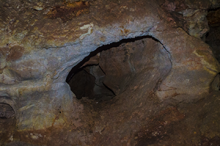Article
A hole in the surface bedrock through which air passes. These blowholes can occur in sea caves where the pressure of the water blasts a hole through the roof of the cave, and on land where differences in air pressure force air out of an underground formation through a hole. These holes can have high velocity winds rushing through them.
Often, blowholes are sites of spiritual and cultural significance, because they seem to replicate the act of breathing. Especially for the dry blowholes on land, such as those found at Wupatki National Monument in Arizona or Wind Cave National Park in South Dakota,when close enough, one can feel air being sucked into the earth and escaping from it, making it seem as if the earth is exchanging breath with the creatures on its surface.
"Wind Cave, Wind Cave National Park, South Dakota, September 22, 2013" by Lodahln is licensed under CC BY-SA.
Manuscripts
A06 People of Darkness (03-06) p. 232
A06 People of Darkness (03-06) p. 234
A06 People of Darkness (03-06) p. 254
A06 People of Darkness (03-06) p. 255
A06 People of Darkness (03-06) p. 258
A06 People of Darkness (03-06) p. 259
A06 People of Darkness (03-06) p. 260
A06 People of Darkness (03-06) p. 262
A06 People of Darkness (03-06) p. 263
A06 People of Darkness (03-06) p. 283
References
Dictionary.com
N.d Blowholes. Collins English Dictionary - Complete & Unabridged 10th Edition.
HarperCollins Publishers. http://dictionary.reference.com/browse/blowholes, accessed
October 24, 2014.
Encyclopædia Britannica Online
N.d. Cave. http://www.britannica.com/EBchecked/topic/100583/cave, accessed October 24, 2014.

